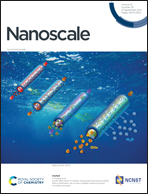Apoptosis-like bacterial death modulated by photoactive hyperthermia nanomaterials and enhanced wound disinfection application†
Abstract
Photothermal therapy (PTT) is considered as an efficient therapeutic strategy for wound disinfection. However, there is a dilemma that on the one hand, the high PTT temperature for killing bacteria (>58 °C) could cause serious injury to normal tissue, however, low-temperature results in unsatisfactory treatment efficiency. To settle the issue, we have proposed a novel approach to gently kill bacteria in an apoptosis-like mode via PTT, in which the bacteria can maintain intact membranes but cannot proliferate. This is different from the typical necrosis-like mode of bacterial cell death requiring higher temperatures. We found that PTT prefers to trigger the gradual efflux of Ca2+/Mg2+ ions from the bacterial intracellular content rather than directly destroy the outer membranes, but can cause the dynamic variation of the membrane surface micromorphology. Hence, the microbial viability of E. coli can be dynamically changed from the live state to an apoptosis-like state (45–55 °C), then to apoptosis/necrosis (ca. 58 °C), and finally to necrosis (>61 °C). Based on this strategy, we can kill bacteria through an apoptosis-like mode. Better healing efficacy of mice wounds was achieved at a PTT temperature of 50 °C as compared to that at 58 °C, which sheds light on the wound disinfection and healing applications in clinics with a mild PTT strategy.



 Please wait while we load your content...
Please wait while we load your content...